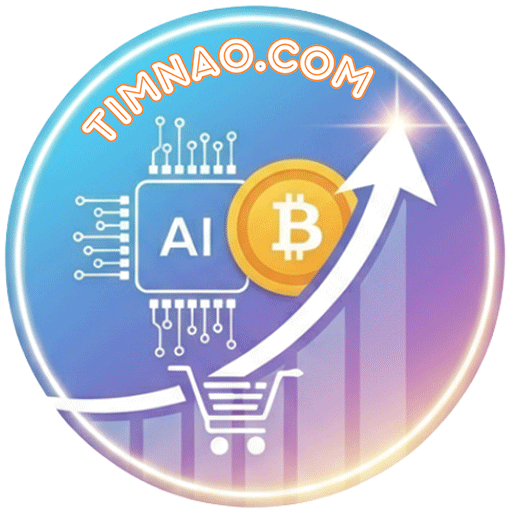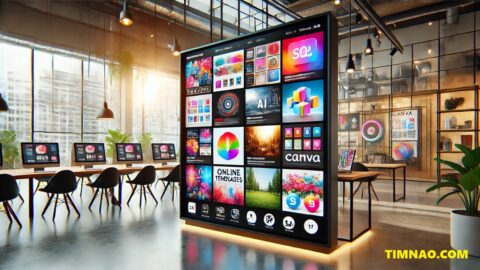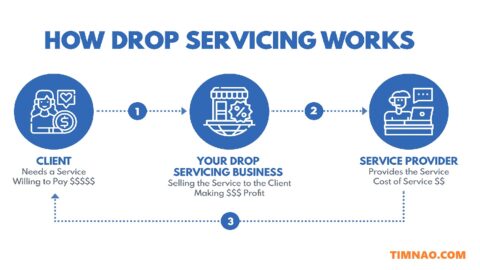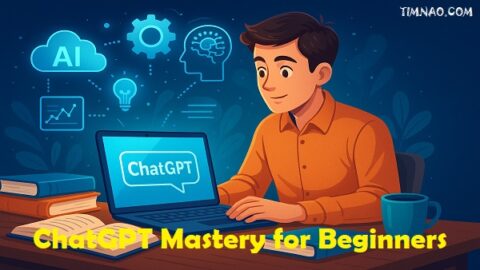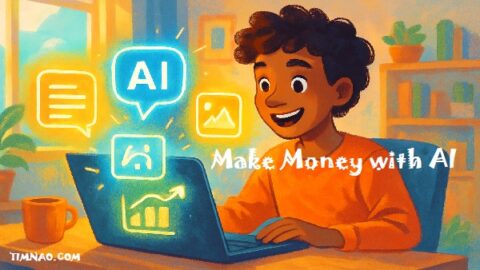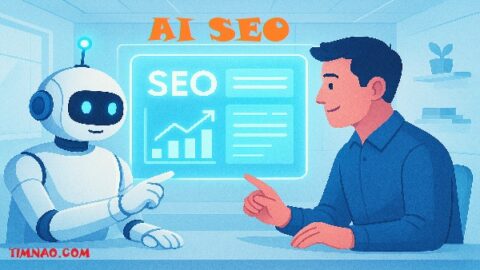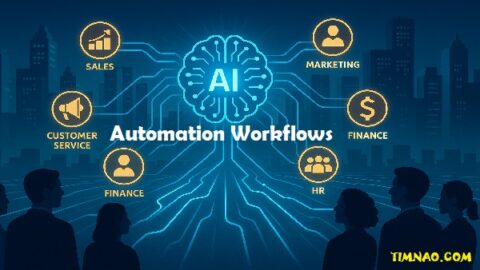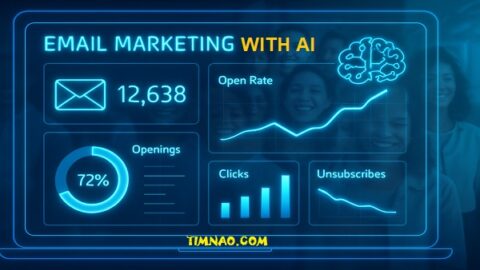B2B Digital Marketing Made Simple: A No‑Stress, High‑Impact Beginner’s Playbook 🚀
B2B digital marketing isn’t reserved for big teams or big budgets. If you can describe your best customer, map a simple journey, and send helpful follow-ups, you can earn attention and pipeline. In this guide, you’ll learn how to create a beginner‑friendly customer journey map, build a minimum viable funnel, and turn interest into revenue with lead nurturing—without drowning in jargon.
Along the way, you’ll get current, real‑world context. Buying groups are larger and more digital than ever. A typical B2B purchase involves six to ten stakeholders, each bringing their own research to the table, which makes clarity and consistency in your marketing crucial.
Table of Contents
- 🎯 Start Here: Why This Matters in 2025
- 🧭 A 3‑Step Roadmap for Beginners
- 🧑🤝🧑 Personas & ICP: Nail Your Audience
- 🗺️ Customer Journey Maps That Drive Action
- 🏗️ Build a Minimum Viable Funnel (MVF)
- 🔎 SEO for 2025: Search + AI Overviews
- 💰 Paid Media Without Waste
- 📬 Email & Automation That Actually Works
- 🤝 Nurturing, Handoffs & Social Selling
- 🎯 ABM Lite: Focus on the Right Accounts
- 📊 Measurement, Consent & Analytics 101
- 🤖 Smart MarTech & AI for Small Teams
- 📅 Your 90‑Day Action Plan
- 🛠️ Common Pitfalls & Quick Fixes
- 🙋 FAQs: Beginner Questions About B2B Digital Marketing Answered
- 📝 Key Lessons & Takeaways
🎯 Start Here: Why This Matters in 2025
If you’re just starting with B2B digital marketing, 2025 is a unique moment. Buyers no longer depend on salespeople to explain their options—they do their homework first. A typical B2B purchase now involves six to ten decision-makers, each armed with independent research and personal preferences. That means your marketing needs to align different people, across different roles, and at different stages of readiness.
The landscape has also shifted in three big ways:
- Search is evolving. Google’s AI Overviews summarize answers directly in search results. If your content isn’t concise, trustworthy, and backed by evidence, you risk being left out of these summaries. Visibility today is about clarity and authority, not volume.
- Privacy rules are reshaping data use. Even though Google paused its plan to eliminate cookies, companies can’t rely on third-party data forever. Collecting first-party data—like emails, demo requests, and webinar sign-ups—is more important than ever.
- Younger buyers dominate. Millennials and Gen Z now make up most of the buying group. They expect self-service, mobile-friendly experiences, and dislike being “sold to” too early. If your marketing isn’t frictionless and transparent, they’ll click away.
In short, success in 2025 doesn’t require a massive budget. It requires focus. Beginners who learn to listen to buyers, map their journey, and build a simple funnel will see results faster than those trying to do everything at once.
🧭 A 3-Step Roadmap for Beginners
So, where should you begin? Instead of scattering your energy across every channel, follow a three-step roadmap: Listen, Map, Build. Think of it as a survival kit for beginners—clear, actionable, and flexible enough to grow with you.
Step 1: Listen 👂
The first step is simple but powerful: listen to your buyers. Too often, companies jump straight into writing blog posts or running ads without knowing what their audience actually wants.
Here’s how to start listening effectively:
- Talk to real customers. Schedule five quick interviews with past or current clients. Ask what triggered their search, what obstacles slowed them down, and what made them finally decide.
- Review sales conversations. If you have recordings or notes from sales calls, pay attention to recurring words. The exact phrases buyers use often become your most effective headlines.
- Scan support tickets. The problems customers bring up after buying show where confusion lingers. Turning those into pre-purchase content can remove objections early.
- Check search intent. Tools like AnswerThePublic or Semrush reveal what people type into search engines. You’ll see unfiltered questions—gold for beginner marketers.
👉 Quick tip for beginners: Instead of writing long personas filled with guesses, create a one-page sheet that lists:
- Job title & responsibilities
- Main pain points
- Desired outcome
- Common objections
This lean approach ensures you focus on what matters: how your solution actually helps.
Step 2: Map 🗺️
Once you know your audience, the next step is to create a customer journey map. This is a simple way to visualize how a buyer goes from realizing they have a problem to deciding on your product.
For beginners, keep it lightweight—no need for a 50-slide deck. Aim for five clear stages:
- Problem aware – “Something isn’t working.”
- Researching solutions – Exploring blogs, LinkedIn, podcasts.
- Comparing options – Checking features, pricing, reviews.
- Validation – Looking for case studies, proof, ROI calculators.
- Decision – Requesting a demo, talking to sales.
For each stage, jot down:
- The main question buyers ask. (e.g., “How can I speed up onboarding?”)
- The best content format. (blog, video, checklist, webinar)
- A fast-track option. (chatbot, demo request, consultation button)
👉 Example map:
- An IT manager feels onboarding is too slow (problem aware).
- They search “speed up employee onboarding” and land on your blog (research).
- They download your “Onboarding Software Comparison Checklist” (compare).
- They watch a short case study video proving 30% time savings (validate).
- They click “Book a Demo” on the thank-you page (decision).
This map shows you exactly where to focus content and what path to optimize first.
Step 3: Build 🏗️
With your journey mapped, it’s time to build. But here’s the secret: you don’t need an endless stream of content or expensive tools. You just need a Minimum Viable Funnel (MVF).
An MVF is a lean system that takes a buyer from curiosity to conversion without overcomplication. It typically includes:
- One pillar page. A long, detailed guide answering your buyer’s top problem. Example: “The Complete Guide to Faster Employee Onboarding.”
- One gated resource. A checklist, template, or calculator that earns you an email address.
- A thank-you page with a fast-track CTA. Add a short video and a “Book a 15-minute consult” button.
- A 5-email nurture sequence. Each email delivers value, tells a story, or answers objections.
- Simple retargeting. Lightweight ads reminding visitors you exist and inviting them back.
👉 Beginner-friendly email sequence:
- Email 1: Deliver the checklist and share one bonus tip.
- Email 2: Teach with a short story or how-to.
- Email 3: Share a mini-case study with real numbers.
- Email 4: Invite them to a consult or demo.
- Email 5: Address the top three objections you hear most.
This funnel doesn’t require a massive team. You can build it with tools like WordPress or Webflow for pages, Mailchimp for email, and Calendly for scheduling.
The beauty of the MVF is that it creates momentum. Instead of scattered efforts, every touchpoint works together: one strong guide, one lead magnet, one follow-up sequence. As you grow, you can add layers—but this is enough to start winning.
By listening, mapping, and building, you create a marketing system that feels intentional, not random. Every email, blog post, and call-to-action ties back to your buyer’s journey.
And here’s the best part: you’ll know what to improve next because the data will show you. If lots of people visit your pillar page but don’t download the checklist, the problem is the lead magnet. If they download but don’t book a consult, the thank-you page needs tweaking.
This clarity is what keeps beginners from getting overwhelmed. You don’t need to master every channel in 2025. You need to master the basics—listen, map, build—and let your funnel do the heavy lifting.
🧑🤝🧑 Personas & ICP: Nail Your Audience
If you’re new to B2B digital marketing, defining your audience is the single most important step you can take. Without it, even the most polished campaign will fall flat because it’s aimed at “everyone”—and ends up resonating with no one. That’s where Personas and the Ideal Customer Profile (ICP) come in.
Personas vs. ICP: Why You Need Both
- ICP (Ideal Customer Profile): The description of the type of company that gets the most value from your product or service. It’s based on firmographics: industry, size, location, growth stage, and tech stack.
- Persona: A semi-fictional profile of the people inside that company—decision-makers, influencers, or end users. Personas go beyond demographics to capture motivations, fears, and buying triggers.
👉 Think of it this way: your ICP is the neighborhood. Personas are the individuals living in the houses. You need both to know where to focus and how to connect.
Building Your ICP as a Beginner
Start simple. You don’t need a consultant or a giant dataset—just a structured look at your best-fit customers.
- Audit your existing customers. Which industries or company sizes renew more often or spend more with you?
- Identify firmographics. Note industry, company size, geography, and growth stage.
- Spot triggers. Look for events that signal a potential fit—funding rounds, mergers, rapid hiring, or regulatory shifts.
- Tech compatibility. Which tools do your happiest customers already use that integrate well with your product?
👉 Example ICP (Onboarding Software):
- Mid-market SaaS firms, 200–500 employees
- Hiring 20+ new staff per quarter
- Already using Slack and Salesforce
- Located in North America or Western Europe
This ICP tells you exactly which companies are worth pursuing and which ones to avoid.
Creating Personas That Work
Inside your ICP, there are usually 6–10 stakeholders involved in a decision. Don’t overwhelm yourself—start with two to three key personas:
- Economic Buyer: CFO, COO, or VP who controls the budget.
- Technical Gatekeeper: IT Manager or Security Lead who validates compliance and integrations.
- End User or Champion: The HR Manager, Sales Lead, or Operations Manager who feels the pain daily.
👉 Beginner Persona Example: HR Manager
- Role: Runs onboarding for all new hires.
- Goal: Reduce time-to-productivity by 30%.
- Pain Point: Manual paperwork, inconsistent experiences.
- Objection: “We don’t have the budget for another tool.”
- Preferred Content: Practical checklists, case studies with metrics.
👉 Beginner Persona Example: IT Manager
- Role: Ensures new tools are secure and integrate smoothly.
- Goal: Minimize risk, avoid adding complexity.
- Pain Point: Tools that don’t work with existing SSO.
- Objection: “This will be a nightmare to manage.”
- Preferred Content: Technical docs, integration guides, vendor security checklists.
Common Beginner Mistakes with Personas
- Guessing instead of listening. Build from real customer interviews and sales call notes.
- Over-detailing irrelevant info. Don’t waste time on “likes coffee or tea.” Focus on what influences their buying decision.
- Creating too many personas. Start lean with 2–3 core personas.
👉 Action step for this week: Talk to three customers or prospects. Capture their goals, objections, and decision process. Use this input to refine your ICP and write your first persona.
🗺️ Customer Journey Maps That Drive Action
Once you know who you’re marketing to, the next step is understanding how they buy. A customer journey map turns random marketing into a guided experience. It shows the path from awareness to decision—and helps you know exactly what content to create.
Why Customer Journey Maps Matter
Without a journey map, your marketing efforts are guesswork. You might create blog posts or ads that don’t align with what buyers need at that stage. A journey map gives you clarity: every touchpoint has a purpose, every piece of content answers a question.
Think of it like a trail map. Without signs, hikers wander or quit. With clear markers, they keep moving forward to the destination.
The Five Stages of a Beginner-Friendly Journey Map
- Awareness (Problem Aware):
- Buyer realizes they have a problem.
- Question: “Why is onboarding taking too long?”
- Content: Blog posts, infographics, explainer videos.
- Consideration (Solution Search):
- Buyer looks for possible approaches.
- Question: “What tools can help me speed onboarding?”
- Content: Guides, checklists, webinars.
- Evaluation (Vendor Comparison):
- Buyer compares specific providers.
- Question: “How does your solution compare to others?”
- Content: Case studies, feature comparison charts, ROI calculators.
- Decision (Purchase Ready):
- Buyer chooses whether to buy.
- Question: “Is this worth the cost and effort?”
- Content: Live demos, testimonials, free trials.
- Post-Purchase (Retention & Advocacy):
- Buyer decides whether they’re happy.
- Question: “Is this delivering the promised value?”
- Content: Onboarding guides, customer success stories, referral incentives.
Building Your First Journey Map
Here’s a simple process for beginners:
- List your personas. Example: HR Manager, IT Manager.
- Write their main question at each stage. Keep it short and realistic.
- Match content to questions. Don’t overproduce—choose one content type per stage.
- Mark drop-off points. Where do people tend to lose momentum?
👉 Mini Example for HR Manager Persona:
- Awareness: Reads “5 Causes of Slow Onboarding” blog post.
- Consideration: Downloads “Onboarding Software Checklist.”
- Evaluation: Reads a case study showing 30% faster onboarding.
- Decision: Books a demo.
- Post-Purchase: Gets a customer success playbook.
How to Use Journey Maps in Practice
- Content planning: Your journey map becomes your editorial calendar.
- Ad targeting: Run awareness ads with educational blogs; use retargeting for case studies and demos.
- Sales alignment: Give your sales team content tied to each stage, so they reinforce—not repeat—your messaging.
Common Pitfalls to Avoid
- Overcomplicating the map. Keep it lean with 5–7 stages.
- Ignoring multiple stakeholders. Each persona may take a slightly different path—map at least two.
- Skipping post-purchase. Existing customers can drive renewals and referrals.
Why This Step Pays Off
When you build journey maps, you stop guessing and start guiding. Buyers feel supported at every step, and you gain a clear structure for content, ads, and handoffs to sales. Most importantly, it makes marketing measurable: you can track progress stage by stage and fix gaps with precision.
🏗️ Build a Minimum Viable Funnel (MVF)
When you’re just starting in B2B digital marketing, it’s easy to feel like you need dozens of landing pages, a library of blog posts, and multiple ad campaigns to compete. The truth? You don’t. What you really need is a Minimum Viable Funnel (MVF)—a lean system that captures attention, nurtures interest, and directs prospects toward a clear next step.
An MVF doesn’t try to do everything at once. It focuses on creating just enough structure to prove your process works and give you a baseline for optimization. Think of it as building a simple but sturdy bridge that connects curiosity to conversion.
The 5 Essential Pieces of an MVF
- A Pillar Page
- This is your in-depth guide on the #1 problem your target audience faces.
- It should be structured like a “hub” that answers key questions, links to supporting posts, and positions you as a trusted source.
- Example: “The Complete Guide to Reducing Employee Onboarding Time.”
- A Gated Resource
- A practical, high-value asset people exchange their email for.
- Keep it simple: checklist, template, or calculator.
- Example: “Onboarding Checklist: Cut 30% of Training Time in 10 Steps.”
- A Thank-You Page with a Fast-Track CTA
- After someone downloads your resource, give them a shortcut to talk to you.
- Add a short video, a demo booking link, or a “Schedule a Free Consultation” button.
- A 5-Email Nurture Sequence
- Each email should deliver value, reduce friction, and invite them forward.
- Example sequence:
- Email 1: Deliver the resource + one quick bonus tip.
- Email 2: Share a short success story.
- Email 3: Highlight 3 common mistakes to avoid.
- Email 4: Offer a consultation/demo.
- Email 5: Tackle top objections head-on.
- Light Retargeting Campaigns
- Use LinkedIn or Google Display ads to stay visible.
- Promote your resource, case study, or demo to people who’ve already visited your site.
Why an MVF Works
- Simple to launch. You can build this with WordPress or Webflow for pages, Mailchimp for email, and Calendly for scheduling.
- Focused on results. Instead of random activity, every element of your funnel pushes toward one action: book a demo or consultation.
- Easy to optimize. With only five moving parts, it’s clear what to fix when something underperforms.
👉 Action step: If you do nothing else this quarter, launch your MVF. It’s better to have one clean funnel running than 20 half-finished campaigns.
🔎 SEO for 2025: Search + AI Overviews
Search is still the backbone of B2B digital marketing, but in 2025 the rules have changed. Google’s AI Overviews now reshape how information appears on results pages, and performance metrics like INP (Interaction to Next Paint) impact visibility. Beginners who adapt early will get ahead of competitors who stick to old tactics.
What AI Overviews Mean for You
- AI-generated summaries now appear above traditional links for many queries. They pull in snippets, stats, and structured answers.
- Your content needs to be fact-rich, concise, and well-structured to be included.
- Instead of writing long fluffy blogs, focus on:
- Clear definitions
- Step-by-step instructions
- Tables, checklists, or mini case studies
- Original data and statistics
👉 Example: Instead of a vague article on “Why onboarding matters,” create a comparison table of onboarding software, or a stat-driven mini-study like “Average Onboarding Time in Tech Companies (2024 Data).” These are the types of assets AI Overviews are more likely to cite.
SEO Checklist for Beginners in 2025
- Keyword Strategy
- Pick 10–20 keywords across three categories:
- Problem-based (e.g., “slow employee onboarding”)
- Solution-based (e.g., “best onboarding software”)
- Comparison (e.g., “Tool A vs Tool B”)
- Use tools like Ahrefs, Semrush, or Google Search Console.
- Pick 10–20 keywords across three categories:
- Content Structure
- Use the pillar + cluster model:
- Pillar = long-form guide.
- Cluster = shorter posts linking back to the pillar.
- Add FAQ sections that answer questions in plain language.
- Use the pillar + cluster model:
- Technical SEO & Core Web Vitals
- Google replaced FID with INP in March 2024. Pages need to respond quickly to clicks and taps.
- Beginner fixes:
- Compress images.
- Reduce heavy third-party scripts.
- Avoid layout shifts (jumping buttons/menus).
- Evidence & Originality
- Add screenshots, data tables, and short case snippets.
- Publish small original surveys or benchmarks—these stand out to Google’s AI systems.
- Track and Adjust
- Check both “All” and “Web” filters in Search Console.
- If traffic drops, review whether AI Overviews are covering your target queries.
Why SEO Still Matters
Even with AI Overviews, search remains where buyers start their journey. According to recent studies, over 70% of B2B buyers begin research on Google before talking to a vendor. If your brand doesn’t show up, you’re invisible.
👉 Action step: Create one pillar guide this month. Add 3–5 cluster posts that link back to it. Include at least one table, one diagram, and one FAQ section. This gives you a solid chance of being included in AI Overviews while also ranking in traditional results.
💰 Paid Media Without Waste
Paid ads can feel intimidating for beginners. The fear is real: “What if I burn my budget without results?” The good news is you don’t need a massive spend to see impact—you just need focus. In 2025, the smartest paid media strategy is to start small, aim precisely, and expand only after proving results.
Why Paid Media Still Matters
Organic search and content take time to gain traction. Paid media helps you:
- Reach the right audience quickly. Ads let you target by intent (search terms) or firmographics (industry, job title).
- Test messages faster. Instead of waiting months to see if a blog post resonates, you’ll know within days if an ad headline works.
- Amplify proven content. Ads put your best guides, checklists, and demos in front of more of the right people.
For beginners, the key is discipline. Don’t chase every channel. Start with one or two where your ICP spends time and scale from there.
Beginner-Friendly Paid Media Channels
- Search Ads (Google + Microsoft)
- Best for high-intent queries like “onboarding software demo” or “B2B CRM comparison.”
- Use exact match for core terms, avoid broad match at first.
- Always set negative keywords to avoid irrelevant clicks.
- LinkedIn Ads
- Great for targeting firmographics: job titles, industries, and company size.
- Start with Sponsored Content (promoted posts) and Document Ads (lead-gen via guides/checklists).
- Use your ICP filters to narrow targeting (e.g., “HR Managers in SaaS companies with 200–500 employees”).
- Retargeting Ads
- Simple campaigns to remind past visitors about you.
- Promote mid-funnel assets: case studies, demo invites, or comparison guides.
- Keep frequency low (2–3 impressions per week) to avoid annoying prospects.
Setting a Starter Budget
- Begin with $500–$1,500/month split between search and LinkedIn.
- Test one audience, one ad creative, and one landing page at a time.
- Review weekly: pause underperformers, double down on winners.
👉 Action Step: If you’re launching ads for the first time, pick one ICP segment, one keyword set, and one gated asset. Keep it lean, and measure only cost per lead and conversion to meeting.
📬 Email & Automation That Actually Works
Email remains the backbone of B2B marketing. Done right, it’s personal, measurable, and low-cost. Done wrong, it clogs inboxes and damages your brand. In 2025, inbox providers are stricter about deliverability, and buyers are quicker to ignore generic blasts. Beginners should focus on quality, not quantity.
Why Email Still Delivers
- Direct ownership: You control the list, unlike social media where algorithms dictate reach.
- High ROI: Industry data shows $30–$40 return for every $1 spent on email.
- Personalization potential: Even simple segmentation boosts engagement dramatically.
Deliverability Basics Every Beginner Must Nail
- Authenticate your sending domain. Set up SPF, DKIM, and DMARC. Most platforms like Mailchimp or HubSpot have step-by-step guides.
- Keep lists clean. Remove bounces and inactive emails regularly.
- Make unsubscribe easy. A one-click opt-out keeps you compliant and improves reputation.
Building a Beginner-Friendly Email Funnel
- Lead Capture: Use your MVF’s gated resource to collect emails.
- Welcome Sequence (5 emails):
- Email 1: Deliver the promised asset + a quick bonus tip.
- Email 2: Share a mini how-to (short blog or video).
- Email 3: Case study showing clear ROI.
- Email 4: Invite to a demo or consultation.
- Email 5: Tackle objections or FAQs.
- Ongoing Nurture: Weekly or biweekly value-driven content (e.g., tips, templates, benchmarks).
👉 Pro Tip: Keep emails under 200 words. Short, scannable, and value-packed beats long essays.
Smart Automation Without Overwhelm
- Start with one workflow: “If user downloads checklist → send 5-email nurture.”
- Score leads lightly: Assign points for actions (e.g., +10 for demo click, +5 for case study view).
- Hand off to sales: When a lead reaches a threshold (e.g., requests pricing or books a call), notify your sales team instantly.
Platforms to explore:
Common Mistakes Beginners Make
- Measuring opens as success. With privacy updates, open rates are unreliable. Focus on clicks and replies.
- Sending too often. Don’t flood inboxes—stick to 1–2 sends per week max.
- Generic subject lines. “Company Update #5” won’t get clicks. “3 Mistakes Slowing Your Onboarding” will.
👉 Action Step: This week, set up a 5-email sequence for one persona. Use short, practical subject lines and one clear CTA in each email.
🤝 Nurturing, Handoffs & Social Selling
For beginners in B2B marketing, generating leads is only half the battle. The real challenge comes in nurturing those leads, knowing when to pass them to sales, and supporting your sales team through channels like LinkedIn. This is where many first-time marketers stumble—leads get “stuck,” sales complains about poor quality, and momentum slows. Let’s fix that.
What Lead Nurturing Really Means
Lead nurturing isn’t about spamming people with constant emails. It’s about building trust over time by answering questions, removing doubts, and showing value. For beginners, think of nurturing as a mix of three things:
- Educating – Provide helpful insights that make prospects smarter.
- De-risking – Share stories, testimonials, or data that reduce uncertainty.
- Inviting – Offer a clear next step (demo, consult, trial) at the right time.
👉 Example: A prospect downloads your onboarding checklist. Instead of pushing “Buy Now,” your nurture sequence:
- Sends a tip on onboarding best practices.
- Shares a case study showing real ROI.
- Offers a 15-minute consult when they’ve engaged multiple times.
Defining the Handoff to Sales
A common beginner mistake is passing leads too early—or too late. The fix? Define MQL (Marketing Qualified Lead) and SQL (Sales Qualified Lead) thresholds together with sales.
- MQL: Someone who has shown meaningful interest (e.g., downloaded 2+ assets, visited pricing page).
- SQL: Someone signaling intent (e.g., requested a demo, asked for pricing, returned repeatedly to comparison pages).
Once a lead reaches SQL, automate the handoff:
- Trigger a CRM alert (via HubSpot or Salesforce).
- Drop the lead into a Slack channel for instant visibility.
- Send a summary of their activity so sales knows what they’ve engaged with.
Social Selling for Beginners
“Social selling” is a buzzword, but at its core, it means using social platforms to build credibility and relationships.
For beginners, start with LinkedIn:
- Optimize profiles: Sales reps should have professional, helpful profiles—not “hard-sell” bios.
- Share consistently: Post 1–2 times per week with insights, stories, or curated industry content.
- Engage thoughtfully: Comment on buyer posts, join relevant discussions, and send short, value-driven connection messages.
👉 Beginner Playbook for LinkedIn Social Selling:
- Week 1: Post a simple tip or lesson from a client success.
- Week 2: Share an industry stat and ask your network a question.
- Week 3: Comment on 5 relevant posts from target accounts.
- Week 4: Share a 2-minute video explaining one feature or use case.
Over time, this builds trust and keeps your company top-of-mind without feeling pushy.
🎯 ABM Lite: Focus on the Right Accounts
As a beginner, you don’t need enterprise-level Account-Based Marketing (ABM) software. You can practice “ABM Lite”: focusing on a short list of best-fit accounts and personalizing lightly to win their attention.
Why ABM Lite Works
In B2B, not all leads are equal. A single closed deal from the right company can outweigh dozens of small accounts. ABM Lite helps you:
- Prioritize companies that match your ICP.
- Personalize your outreach without overwhelming your resources.
- Align marketing and sales around a shared “dream list” of accounts.
Building Your First ABM Lite Program
- Create a Target List
- Choose 50–100 accounts that match your ICP.
- Use filters like industry, size, or recent growth signals.
- Light Personalization
- Customize landing page intros by industry (e.g., “Solutions for FinTech HR Leaders”).
- Share a case study relevant to that vertical.
- Add a tailored CTA: “See how SaaS firms cut onboarding time by 30%.”
- Target via LinkedIn
- Use LinkedIn’s Matched Audiences to upload your account list.
- Run Sponsored Content or Document Ads that link directly to your tailored assets.
- Measure by Account, Not Just Leads
- Track whether accounts are engaging: website visits, content downloads, meeting bookings.
- Align sales and marketing updates around “account progress” instead of just lead counts.
Beginner-Friendly Tools for ABM Lite
- LinkedIn Ads for targeting.
- HubSpot or ActiveCampaign for light segmentation and personalization.
- Clearbit or ZoomInfo for enrichment (optional, but helpful).
Common Pitfalls to Avoid
- Trying to personalize everything. Focus on industry-level personalization at first.
- Neglecting sales alignment. Make sure your sales team works the same account list.
- Measuring too narrowly. Don’t obsess over leads—look at whether target accounts are moving toward demos or proposals.
👉 Action Step: This week, build a list of 50 accounts that fit your ICP. Draft one landing page intro and one case study tailored to them. Launch a small LinkedIn campaign to that audience only.
📊 Measurement, Consent & Analytics 101
If you can’t measure it, you can’t improve it. This old saying is especially true in B2B digital marketing. For beginners, measurement often feels overwhelming—too many metrics, confusing dashboards, and endless acronyms. The trick is to keep things simple: measure what matters for your funnel, respect user consent, and build a beginner-friendly analytics setup you can actually use.
Why Measurement Matters
- Focus: Tracking the right metrics helps you avoid vanity numbers like “likes” or “followers” that don’t drive revenue.
- Alignment: When marketing and sales share the same dashboard, everyone rows in the same direction.
- Iteration: Measurement gives you signals—what to double down on and what to cut.
The 4 Core Stages to Measure
- Discovery
- Metrics: Website visits, search impressions, ad reach.
- Beginner tools: Google Search Console, LinkedIn Campaign Manager.
- Consideration
- Metrics: Content engagement, time on site, downloads, webinar attendance.
- Tools: Google Analytics 4 (GA4), HubSpot.
- Decision
- Metrics: Demo requests, proposals sent, conversion rates.
- Tools: CRM platforms like Salesforce or HubSpot.
- Retention/Expansion
- Metrics: Renewals, upsells, NPS (Net Promoter Score).
- Tools: Customer success platforms, surveys, or even spreadsheets at first.
👉 Action step: Don’t try to track 50 KPIs. Pick 1–2 metrics per stage and review them weekly.
Consent & Privacy Basics for Beginners
In 2025, respecting privacy isn’t optional—it’s essential. Buyers expect transparency, and regulators enforce it.
- Cookie & Consent Banners
- Use a simple banner asking for consent to track analytics and run ads.
- If targeting Europe, make sure you comply with GDPR by giving real choices.
- Google Consent Mode v2
- This lets your Google tags (Ads, Analytics) adapt to whether users consent.
- Beginners should enable this to stay compliant without losing all data.
- Email Permissions
- Always use opt-in lists. Don’t buy emails.
- Make unsubscribe links visible and one-click.
👉 Beginner tip: Start collecting first-party data—your own email list, demo requests, event sign-ups. This is future-proof and builds stronger trust than relying on rented audiences.
Building a One-Page Beginner Dashboard
You don’t need a massive BI tool to get started. A single-page view is enough to keep you on track.
- Traffic by source (organic, paid, social, direct)
- Top content (pillar pages, resources)
- Leads by source
- Demo bookings or consultations scheduled
- Pipeline influenced by marketing
Tools like Google Looker Studio let you connect GA4, Search Console, and your CRM into one dashboard—no coding required.
👉 Action step: Build your first one-page dashboard this month. Review it every Friday with your team.
🤖 Smart MarTech & AI for Small Teams
Marketing technology (MarTech) is exploding—there are thousands of tools out there. As a beginner, you don’t need them all. In fact, using too many can paralyze you. Instead, build a lean stack and use AI as a productivity booster, not a crutch.
The Minimum MarTech Stack for Beginners
- Analytics & Tracking: Google Analytics 4 + Google Search Console.
- CRM & Lead Management: HubSpot (free tier works for many), Salesforce if you’re larger.
- Email & Automation: Mailchimp, Brevo, or HubSpot Marketing Hub.
- Landing Pages & CMS: WordPress or Webflow for fast, flexible pages.
- Ads Management: Google Ads and LinkedIn Campaign Manager.
- Scheduling & Meetings: Calendly or Chili Piper.
👉 Beginner tip: Start with tools that integrate easily. You don’t want to manually stitch data together every week.
Using AI Without Losing Authenticity
AI tools can save beginners hours of work, but they’re not a replacement for your own thinking. Use them for speed, not for soul.
Practical AI Uses:
- Drafting first-pass blog outlines.
- Turning webinars into social media snippets.
- Summarizing long call transcripts.
- Generating subject line variations for A/B testing.
Where to be careful:
- Don’t let AI create final drafts of content without review—it can sound generic or inaccurate.
- Avoid using AI for sensitive customer communications (apologies, renewals, high-stakes deals).
👉 Beginner action: Pick one AI tool and apply it to a repetitive task, like turning blog posts into LinkedIn posts. Measure time saved each week.
Future-Proofing as You Scale
As your team grows, expand your stack carefully:
- Add an ABM platform (like RollWorks or 6sense) only when you have a dedicated sales team working target accounts.
- Invest in data enrichment tools (like Clearbit) only when your lead volume justifies it.
- Layer in advanced analytics (like Tableau or Power BI) when you outgrow simple dashboards.
Common Beginner Mistakes with MarTech
- Shiny Object Syndrome: Buying tools you don’t use.
- Lack of integration: Choosing platforms that don’t talk to each other.
- Over-automation: Making processes robotic and impersonal.
👉 Golden rule: Every tool should either save time, improve conversion, or provide better data. If it doesn’t, you don’t need it.
📅 Your 90-Day Action Plan
One of the hardest things for beginners is knowing where to start. There’s so much advice out there that it’s easy to freeze and do nothing—or try to do everything at once and burn out. That’s why having a 90-day roadmap matters. It breaks your marketing journey into small, achievable steps.
This plan is designed to give you quick wins early, while also building a foundation for sustainable growth. Each phase has clear actions you can complete without an agency or big team.
Days 1–14: Listen & Align
Your first two weeks are about clarity, not campaigns.
- Talk to customers and sales. Collect the language, questions, and objections that real buyers use.
- Draft your ICP and 2 personas. Keep them lean and practical.
- Map the journey. Sketch the 5–7 stages your buyers go through.
- Audit your website. Is it clear what you do? Can someone book a demo in 1 click?
👉 Deliverable: One-page document with ICP, personas, and a basic journey map.
Days 15–30: Build Your Minimum Viable Funnel
Now it’s time to put structure in place.
- Create a pillar page. Write a comprehensive guide around your #1 problem/solution.
- Design one gated resource. A checklist or template is enough.
- Set up a thank-you page. Add a short video + calendar link.
- Launch a 5-email nurture sequence. Use your customer insights for subject lines.
- Check deliverability. Make sure SPF, DKIM, and DMARC are set up.
👉 Deliverable: A working funnel you can start sending traffic to.
Days 31–60: Drive Traffic & Test
Now that your funnel exists, get people into it.
- Publish cluster content. Add 2–3 shorter blog posts that link to your pillar.
- Run small paid tests. Launch 1 search campaign + 1 LinkedIn campaign.
- Activate retargeting. Keep your brand in front of recent visitors.
- Measure weekly. Track traffic by source, leads captured, and early conversions.
👉 Deliverable: Dashboard with weekly metrics and first paid traffic results.
Days 61–90: Optimize & Scale
This phase is about sharpening what’s working.
- Review your funnel. Which pages or emails perform best? Double down on them.
- Kill weak ads. Reallocate budget to the best keywords/audiences.
- Pilot ABM Lite. Pick 50 dream accounts and personalize lightly.
- Document learnings. Capture what’s working so far and what to test next.
👉 Deliverable: A refined funnel, a clean 50-account ABM Lite list, and a quarterly playbook for the next 90 days.
🛠️ Common Pitfalls & Quick Fixes
Even with a clear plan, beginners often fall into the same traps. Here are the most common—and how to fix them fast.
Pitfall 1: Trying to Market to Everyone
Why it happens: Fear of missing out. Beginners think narrowing focus means losing opportunities.
Quick fix: Revisit your ICP. Ask: “Which type of customer benefits the most from us right now?” Start with one ICP segment, then expand later.
Pitfall 2: Over-engineering Personas
Why it happens: Guides make personas look like 10-page profiles.
Quick fix: Keep it lean—2 personas, one page each. Focus only on goals, pains, objections, and preferred content.
Pitfall 3: Skipping Measurement
Why it happens: Analytics feels complicated.
Quick fix: Build a one-page dashboard with just 5 metrics: traffic by source, top content, leads by source, demos booked, and marketing pipeline.
Pitfall 4: Obsessing Over Vanity Metrics
Why it happens: “Likes” and “followers” feel rewarding.
Quick fix: Tie your goals to actions that drive revenue: email captures, demo bookings, or meetings scheduled.
Pitfall 5: Overusing Automation
Why it happens: Tools make it easy to set up dozens of sequences.
Quick fix: Start with one nurture workflow. Personalize based on persona and journey stage before expanding.
Pitfall 6: Spreading Paid Budget Too Thin
Why it happens: Temptation to test every channel at once.
Quick fix: Start with one high-intent channel (search) and one awareness channel (LinkedIn). Cap spend and test messages slowly.
👉 Rule of thumb: If a task doesn’t clearly connect back to your funnel or dashboard, it’s a distraction for now.
🙋 FAQs: Beginner Questions About B2B Digital Marketing Answered
When you’re new to B2B digital marketing, it’s natural to feel overwhelmed. Below are some of the most common beginner questions—and straightforward answers you can use right away.
“Do I need a big budget to get started?”
No. You can launch an effective marketing engine with less than $1,000 per month if you focus on essentials: one funnel, a small ad campaign, and consistent email nurturing. Bigger budgets help you scale, but clarity beats cash at the start.
“How often should I publish content?”
Quality beats quantity. For beginners, start with one strong pillar guide, a few supporting cluster posts, and a gated resource. Then post 1–2 LinkedIn updates weekly. Once your system is running, increase volume only if you can maintain quality.
“How do I know if my ads are working?”
Don’t judge by clicks alone. Look at cost per lead, demo bookings, and pipeline generated. If ads drive traffic but no conversions, the problem is your landing page or funnel—not necessarily the ads themselves.
“What should I track first in analytics?”
Stick to five beginner-friendly metrics:
- Website traffic by source
- Leads captured (emails)
- Demo/consultation bookings
- Pipeline influenced by marketing
- Cost per lead (if running ads)
“Is email still relevant in 2025?”
Yes—if done right. Email is the only channel you truly own. Keep lists clean, send short and valuable messages, and avoid spamming. Personalized, helpful emails still outperform most social campaigns.
“When should I hand a lead to sales?”
Define MQL (Marketing Qualified Lead) vs. SQL (Sales Qualified Lead) with your sales team. A demo request = SQL. Someone who reads multiple resources and visits your pricing page = MQL. The key is alignment so sales trusts your handoffs.
“What if I can’t afford fancy MarTech?”
You don’t need it to start. Use free or affordable versions of:
- Google Analytics 4 (tracking)
- HubSpot Free CRM (leads)
- Mailchimp or Brevo (emails)
- WordPress or Webflow (site & landing pages)
Grow your stack only when your current tools hit their limits.
“How long until I see results?”
Expect at least 90 days for your first measurable traction, especially if you’re building content and funnels from scratch. Paid ads can bring results sooner, but sustainable momentum usually takes 3–6 months.
✅ Key Lessons & Takeaways
You’ve now walked through the essential building blocks of B2B digital marketing in 2025. Here are the key lessons to keep on your desk as a quick reference:
- Start small with clarity. Define your ICP and 2 personas. Don’t market to everyone.
- Map before you build. Use a customer journey map to guide your content and offers.
- Ship a Minimum Viable Funnel. One pillar guide, one gated asset, a thank-you page, a 5-email nurture, and light retargeting are enough to begin.
- Respect privacy. Collect first-party data, set up consent banners, and authenticate email domains.
- Invest wisely in tools. A lean stack + one AI helper can save time without overwhelming you.
- Measure what matters. Stick to 5 metrics: traffic, leads, demos, pipeline, and cost per lead.
- Align with sales. Define MQL vs. SQL clearly and automate smooth handoffs.
- Use ABM Lite. Focus on 50–100 dream accounts with light personalization.
- Stay consistent. Weekly review of your dashboard and 1–2 social posts per week keep momentum going.
- Think 90 days at a time. Break goals into quarterly sprints—listen, build, test, optimize.
✨ With these lessons in hand, you now have a practical playbook for launching and growing your B2B digital marketing. The key isn’t perfection—it’s consistent action, learning fast, and scaling what works.
